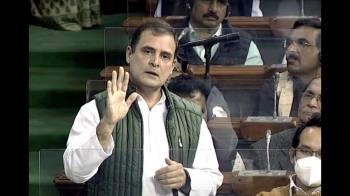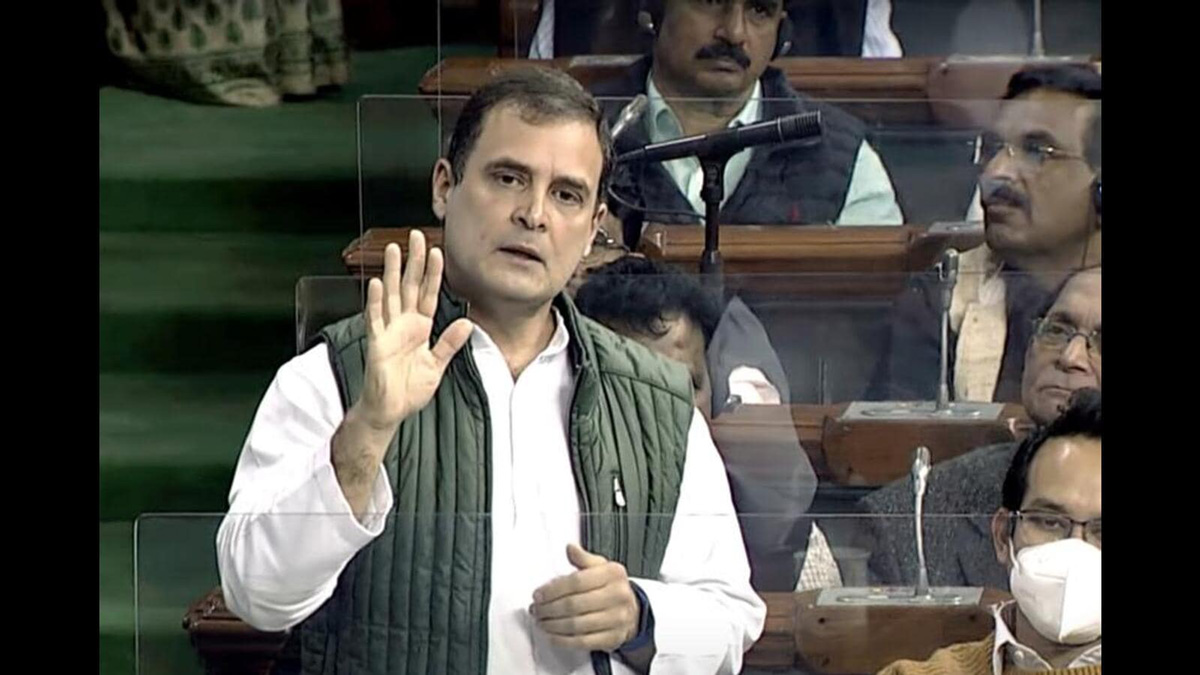
 A. J. Philip
A. J. Philip

Pappu is a derogatory term used by the Sangh Parivar for former Congress President and MP from Wayanad, Rahul Gandhi. He is always projected as a good-for-nothing, clueless leader who moves from one blunder to another.
Such is the power of propaganda, proved first by Adolf Hitler’s close confidante Joseph Goebbels, that even some Congress leaders and supporters themselves believe that he is indeed a political nincompoop, who is yet to make the grade as a political leader.
Every time I heard him speak, I was impressed by his eloquence, clarity of thought and choice of subjects. His 44-minute speech in Parliament on the motion of thanks to the President was no exception.
As someone who used to be called upon to speak at public functions, I know how difficult it is to speak when you are disrupted by the listeners. In Gandhi’s case, by the members of the ruling party.
Yet, it must be said to his credit that his speech could make an impact. It was because he spoke from his heart, unlike the President who read out what the bureaucrats prepared as a speech.
In Gandhi’s case, he came to the House well-prepared to make a speech with a difference so that the members of the erstwhile “party with a difference” could understand that no power on earth could ride roughshod over the people of India from Kanyakumari in the South to the upper reaches of the Himalayas in the North, not to mention those in the West, the East and the Northeast.
One significant observation Gandhi made was that in the President’s long speech that listed the “achievements” of the Modi government, there was no mention of the word “unemployment”. The fact is that it is the worst problem facing the nation today.
The next day, on February 1, Finance Minister Nirmala Sitharaman presented the Budget for 2022-23. Her speech was littered with words like digital, make in India, green, climate, infrastructure and GST.
She also forgot to mention words like unemployment, poverty, food security, informal sector, migrants, daily wagers, health for all, welfare, social protection, women, youth and childcare in her speech, said to be one of the shortest.
These missing words tell a lot about the state of affairs in the country ever since Modi packed his belongings from Ahmedabad in 2014 and moved to Panchavati in New Delhi, with the address, 7, Lok Kalyan Marg, earlier known as 7, Race Course Road.
His is not a simple house. It is a cluster of five bungalows. Panchavati is the place where Peepal, Belpatra, Bad, Amla and Ashoka grow in one direction. I have no idea whether Modi has planted such trees in his residential complex.
For those who are familiar with the story of Valmiki’s Ramayana, it was from Panchavati that Sita was abducted by Ravan.
Modi is certainly not happy with his house. A new mega house for him is under construction as part of the Rs 20,000-crore Central Vista project. It will, hopefully, be ready by the time he completes his second term.
No other Prime Minister showed so much foresight. Nehru just moved into the house vacated by the British military commander. All the subsequent prime ministers, including Lal Bahadur Shastri, VP Singh and Atal Bihari Vajpayee, moved into one of the bungalows built by the British architect Sir Edwin Lutyens.
They were democrats who knew that they would have to move from one election to another and could not think of staying in the same house like the Maharajas of yore.
They were more bothered about doing something for the welfare of the people, rather than leaving a legacy like the one who built a statue for over Rs 2,000 crore, a temple corridor for Rs 300 crore and other vainglorious projects like a bullet train line between Ahmedabad and Mumbai at a cost of over Rs 1 lakh crore.
For the first time, the finance minister mentioned that the government had a long-term vision that covered the next 25 years. We saw how during the Covid-19 pandemic, Sitharaman addressed Press conferences day after day announcing projects and plans that had a total outlay of lakhs of crores of rupees. Nobody knows where all that money came from and went. She is a postmaster in juggling figures.
However, it must be said to her eternal credit that she did not forget the travails of the Indian house maker who has to cook food for the family at least twice a day. She is a blue-blooded South Indian who knows that sambar is to the South Indian what pasta is to the Italian. She also knows that sambar is fast becoming a pan-India dish. One of the essential ingredients of sambar is called perungayam or heeng or asafoetida.
Sitharaman has made this ingredient cheaper for the consumer. Mobile phone chargers have also become cheaper. These are the two takeaways from her Budget. Anyone who prepares sambar and uses the mobile charger will always be grateful to her.
As usual, the minister has made several promises. Modi addressed a rally at Agra in 2014. He arrived there in a helicopter owned by Gautam Adani. That was the first time many people heard the name of Adani, who was an upcoming industrialist from Gujarat. At the Agra rally, he made an announcement.
If he came to power, he would create one crore new jobs every year. There is a saying, “give anything but never a promise you can’t fulfil”. Modi was not bothered. The young men and women who had no jobs fell for his promise and they voted massively for him.
By a rough estimate, he should have created at least 7 crore new jobs by now. What is the truth? There are less employed persons today than was the case a few years ago. The unemployment rate at 23 per cent is the highest in Haryana, ruled by the BJP, which was once an economic wonder.
The whole world saw millions of migrant workers leaving cities like Delhi and Mumbai when the Prime Minister announced an abrupt lockdown. Most of them are yet to return to their workplaces because they are still closed. Gandhi was not wide of the mark when he quoted figures to say that one singular achievement of the government was to push those who had been lifted up from poverty back into poverty.
Small wonder that inequality has been growing by leaps and bounds. The share of the top 10 per cent in the total national income stood at 57.1 per cent, whereas the share of the bottom 50 per cent in the total national income stood at 13.1 per cent.
Let me confess that my monthly income is over Rs 25,000. Some of you may wonder why I am boasting about my income. It is to remind you that 90 per cent of the people have a lesser income. Yet, Modi had promised to make India a $5-trillion economy by 2024. Is India on the way to becoming such an economy?
“India’s real GDP in 2019-20 was Rs 145 lakh crore. This has shrunk by Rs 15-20 lakh crore over the last two years”. Modi had promised that the farmers’ income would double by 2022-23. Cleverly, he did not mention the base level from which the doubling would happen. When I came to Delhi in 1973, the cost of wheat was about Re 1 per kilogram. If that is the base, the farmers’ income has increased manifold.
Otherwise, their condition remains pathetic. While tens of millions of people have been pushed down the ladder of growth during the last seven years, what happened to Adani, who gave his helicopter, reportedly, free of cost, to Modi for electioneering in 2014?
He has become the richest Asian, worth $90.1 billion, according to Forbes’ Real Time Billionaire calculations, and the 10th richest person in the world. He narrowly edged out Mukesh Ambani, head of Reliance Industries, worth just $100 million less at $90 billion.
Ambani was previously the richest Asian billionaire. Both are dear to Modi and are fellow Gujaratis.
Rahul Gandhi has in his speech mentioned some of the sectors like coal mining and trading, airport operations, edible oils, road, rail and water infrastructure, data centres, hydrocarbon exploration, defence and aerospace, multimodal logistics, and agro commodities where Adani enjoys a commanding position.
MR Kumar is the Chairman of the Life Insurance Corporation. His term ended last year. He was given an extension of nine months. He has now been given another extension which will end in March 2023. Why was he given the extensions?
The government has a plan to privatise the LIC, often called the duck that lays the golden eggs. The government had invested Rs 5 crore in the company 64 years ago. The government has received nearly Rs 29,000 crore as dividend from the company. Its embedded value has been assessed at Rs 5 lakh crore. It has assets worth several multiples of this amount.
Kumar’s job is to ensure that the privatisation of LIC is put on the fast track. The LIC has 49 crore policy holders who get much better returns on their policies and pay lesser premium in comparison with the private players. The private players will invest money only to get a better profit. I won’t be surprised if, sooner than later, the LIC becomes a private company. All its social concerns will go for a toss.
The job guarantee scheme was the flagship programme of the previous UPA government. It is named after Mahatma Gandhi. Nobody would have minded if it was renamed after Mahatma Modi and the programme was strengthened.
Far from that, the allocation for the job scheme has fallen drastically in absolute terms. So much for the government’s concern over the growing unemployment. A day before the Budget a regional language newspaper from Delhi interviewed some of its readers on their expectations from the Budget.
A friend who is a lawyer wanted Sitharaman to increase spending on public health. I called her in the evening and told her jokingly that the minister had taken note of her suggestion. The allocation for healthcare was misleading as Sitharaman included water, sanitation, nutrition and pollution control in the overall allocation for healthcare.
As someone who managed two schools, one in Delhi and another in the most aspirational (read backward) district in the country in Haryana, which catered to the poor for about five years, I know the digital divide in education. There is reason to believe that the poor students in India have virtually lost two years of education.
The government is not bothered. It could not think beyond starting some educational television channels. What the children need is classroom-based teaching.
Sitharaman also announced that world-class foreign universities and institutions would be allowed to operate in the GIFT City “free from domestic regulations”. What is GIFT City? It is the Gujarat International Finance Tec-City in Gandhinagar. For state-of-the-art higher education, students from all over India can go to this place. What an idea!
In other words, those who have money will get world-class education. Others can switch on their television channels, if they have a television receiver to study. This is the kind of vision the government has. To be fair to Modi, he has been investing heavily on roads. One only has to recall how Hitler planned Autobahn, the high-speed, limited-access highways.
The new roads will help the rich to drive their BMWs and Mercs at 250 kms per hour. Yes, the poor have their own utility. They will continue to vote for the ruling party when the leaders provide them a concoction of communalism and pride in the mythical past when our sages developed ideas of plastic surgery, aircraft and missiles and bombs!
ajphilip@gmail.com